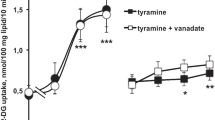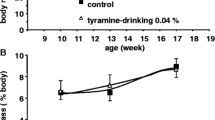Abstract
Tyramine is found in foodstuffs, the richest being cheeses, sausages, and wines. Tyramine has been recognized to release catecholamines from nerve endings and to trigger hypertensive reaction. Thereby, tyramine-free diet is recommended for depressed patients treated with irreversible inhibitors of monoamine oxidases (MAO) to limit the risk of hypertension. Tyramine is a substrate of amine oxidases and also an agonist at trace amine-associated receptors. Our aim was to characterize the dose-dependent effects of tyramine on human adipocyte metabolic functions. Lipolytic activity was determined in adipocytes from human subcutaneous abdominal adipose tissue. Glycerol release was increased by a fourfold factor with classical lipolytic agents (1 μM isoprenaline, 1 mM isobutylmethylxanthine) while the amine was ineffective from 0.01 to 100 μM and hardly stimulatory at 1 mM. Tyramine exhibited a partial antilipolytic effect at 100 μM and 1 mM, which was similar to that of insulin but weaker than that obtained with agonists at purinergic A1 receptors, α2-adrenoceptors, or nicotinic acid receptors. Gi-protein blockade by Pertussis toxin abolished all these antilipolytic responses save that of tyramine. Indeed, tyramine antilipolytic effect was impaired by MAO-A inhibition. Tyramine inhibited protein tyrosine phosphatase activities in a manner sensitive to ascorbic acid and amine oxidase inhibitors. Thus, millimolar tyramine restrained lipolysis via the hydrogen peroxide it generates when oxidized by MAO. Since tyramine plasma levels have been reported to reach 0.2 μM after ingestion of 200 mg tyramine in healthy individuals, the direct effects we observed in vitro on adipocytes could be nutritionally relevant only when the MAO-dependent hepato-intestinal detoxifying system is overpassed.






Similar content being viewed by others
References
Adams F, Boschmann M, Schaller K, Franke G, Gorzelniak K, Janke J, Klaus S, Luft FC, Heer M, Jordan J (2006) Tyramine in the assessment of regional adrenergic function. Biochem Pharmacol 72:1724–1729
Ahmed K, Tunaru S, Tang C, Muller M, Gille A, Sassmann A, Hanson J, Offermanns S (2010) An autocrine lactate loop mediates insulin-dependent inhibition of lipolysis through GPR81. Cell Metab 11:311–319
Alkhouli M, Mathur M, Patil P (2014) Revisiting the “cheese reaction”: more than just a hypertensive crisis? J Clin Psychopharmacol 34:665–667
Atgié C, Sauvant P, Ambid L, Carpéné C (2009) Possible mechanisms of weight loss of Siberian hamsters (Phodopus sungorus sungorus) exposed to short photoperiod. J Physiol Biochem 65:377–386
Berry MD, Gainetdinov RR, Hoener MC, Shahid M (2017) Pharmacology of human trace amine-associated receptors: therapeutic opportunities and challenges. Pharmacol Ther 180:161–180
Borowsky B, Adham N, Jones KA, Raddatz R, Artymyshyn R, Ogozalek KL, Durkin MM, Lakhlani PP, Bonini JA, Pathirana S, Boyle N, Pu X, Kouranova E, Lichtblau H, Ochoa FY, Branchek TA, Gerald C (2001) Trace amines: identification of a family of mammalian G protein-coupled receptors. Proc Natl Acad Sci U S A 98:8966–8971
Bour S, Daviaud D, Grès S, Lefort C, Prévot D, Zorzano A, Wabitsch M, Saulnier-Blache JS, Valet P, Carpéné C (2007) Adipogenesis-related increase of semicarbazide-sensitive amine oxidase and monoamine oxidase in human adipocytes. Biochimie 89:916–925
Camell CD, Sander J, Spadaro O, Lee A, Nguyen KY, Wing A, Goldberg EL, Youm YH, Brown CW, Elsworth J, Rodeheffer MS, Schultze JL, Dixit VD (2017) Inflammasome-driven catecholamine catabolism in macrophages blunts lipolysis during ageing. Nature 550:119–123
Carpéné C, Berlan M, Lafontan M (1983) Lack of functional antilipolytic alpha 2-adrenoceptor in rat fat cell: comparison with hamster adipocyte. Comp Biochem Physiol C 74:41–45
Carpéné C, Bousquet-Melou A, Galitzky J, Berlan M, Lafontan M (1998) Lipolytic effects of beta 1-, beta 2-, and beta 3-adrenergic agonists in white adipose tissue of mammals. Ann N Y Acad Sci 839:186–189
Carpéné C, Castan I, Collon P, Galitzky J, Moratinos J, Lafontan M (1994) Adrenergic lipolysis in guinea pig is not a beta 3-adrenergic response: comparison with human adipocytes. Am J Phys 266:R905–R913
Carpéné C, Galitzky J, Fontana E, Atgié C, Lafontan M, Berlan M (1999) Selective activation of beta3-adrenoceptors by octopamine: comparative studies in mammalian fat cells. Naunyn Schmiedeberg's Arch Pharmacol 359:310–321
Carpéné C, Galitzky J, Saulnier-Blache JS (2016) Short-term and rapid effects of lysophosphatidic acid on human adipose cell lipolytic and glucose uptake activities. AIMS Mol Sci 3:222–237
Carpéné C, Garcia-Vicente S, Serrano M, Marti L, Belles C, Royo M, Galitzky J, Zorzano A, Testar X (2017) Insulin-mimetic compound hexaquis (benzylammonium) decavanadate is antilipolytic in human fat cells. World J Diabetes 8:143–153
Carpéné C, Schaak S, Guilbeau-Frugier C, Mercader J, Mialet-Perez J (2016) High intake of dietary tyramine does not deteriorate glucose handling and does not cause adverse cardiovascular effects in mice. J Physiol Biochem 72:539–553
Carpéné MA, Testar X, Carpéné C (2014) High doses of synephrine and octopamine activate lipolysis in human adipocytes, indicating that amines from Citrus might influence adiposity. In: Hayat CK (ed) Nova Science Publishers Inc Chapter 8:141–168
Castan I, Valet P, Quideau N, Voisin T, Ambid L, Laburthe M, Lafontan M, Carpéné C (1994) Antilipolytic effects of alpha 2-adrenergic agonists, neuropeptide Y, adenosine, and PGE1 in mammal adipocytes. Am J Phys 266:R1141–R1147
Finberg JP, Gillman K (2011) Selective inhibitors of monoamine oxidase type B and the “cheese effect”. Int Rev Neurobiol 100:169–190
Gillman K (2017) “Much ado about nothing”: monoamine oxidase inhibitors, drug interactions, and dietary tyramine. CNS Spectr 22:385–387
Gomez-Zorita S, Treguer K, Mercader J, Carpéné C (2013) Resveratrol directly affects in vitro lipolysis and glucose transport in human fat cells. J Physiol Biochem 69:585–593
Guo K, Li L (2009) Differential 12C-/13C-isotope dansylation labeling and fast liquid chromatography/mass spectrometry for absolute and relative quantification of the metabolome. Anal Chem 81:3919–3932
Jansen SC, van Dusseldorp M, Bottema KC, Dubois AE (2003) Intolerance to dietary biogenic amines: a review. Ann Allergy Asthma Immunol 91:233–240
Johnson CH, Patterson AD, Krausz KW, Kalinich JF, Tyburski JB, Kang DW, Luecke H, Gonzalez FJ, Blakely WF, Idle JR (2012) Radiation metabolomics. 5. Identification of urinary biomarkers of ionizing radiation exposure in nonhuman primates by mass spectrometry-based metabolomics. Radiat Res 178:328–340
Khan MZ, Nawaz W (2016) The emerging roles of human trace amines and human trace amine-associated receptors (hTAARs) in central nervous system. Biomed Pharmacother 83:439–449
Komprda T, Sladkova P, Dohnal V (2009) Biogenic amine content in dry fermented sausages as influenced by a producer, spice mix, starter culture, sausage diameter and time of ripening. Meat Sci 83:534–542
Konakovsky V, Focke M, Hoffmann-Sommergruber K, Schmid R, Scheiner O, Moser P, Jarisch R, Hemmer W (2011) Levels of histamine and other biogenic amines in high-quality red wines. Food Addit Contam Part A Chem Anal Control Expo Risk Assess 28:408–416
Lafontan M, Berlan M (1993) Fat cell adrenergic receptors and the control of white and brown fat cell function. J Lipid Res 34:1057–1091
Lafontan M, Bousquet-Melou A, Galitzky J, Barbe P, Carpéné C, Langin D, Berlan M, Valet P, Castan I, Bouloumie A, et al. (1995) Adrenergic receptors and fat cells: differential recruitment by physiological amines and homologous regulation. Obes Res 3 Suppl 4:507s–514s
Les F, Deleruyelle S, Cassagnes LE, Boutin JA, Balogh B, Arbones-Mainar JM, Biron S, Marceau P, Richard D, Nepveu F, Mauriège P, Carpéné C (2016) Piceatannol and resveratrol share inhibitory effects on hydrogen peroxide release, monoamine oxidase and lipogenic activities in adipose tissue, but differ in their antilipolytic properties. Chem Biol Interact 258:115–125
Lyles GA (1995) Substrate-specificity of mammalian tissue-bound semicarbazide-sensitive amine oxidase. Prog Brain Res 106:293–303
Marti L, Morin N, Enrique-Tarancon G, Prevot D, Lafontan M, Testar X, Zorzano A, Carpéné C (1998) Tyramine and vanadate synergistically stimulate glucose transport in rat adipocytes by amine oxidase-dependent generation of hydrogen peroxide. J Pharmacol Exp Ther 285:342–349
Meissonnier G, Heniquez A, Visentin V, Prevot D, Carpéné C (2003) Histamine antilipolytic action in rat adipocytes: comparison with the effect of tyramine. Inflamm Res 52(Suppl 1):S55–S56
Mercader J, Wanecq E, Chen J, Carpéné C (2011) Isopropylnorsynephrine is a stronger lipolytic agent in human adipocytes than synephrine and other amines present in Citrus aurantium. J Physiol Biochem 67:443–452
Morin N, Lizcano JM, Fontana E, Marti L, Smih F, Rouet P, Prevot D, Zorzano A, Unzeta M, Carpéné C (2001) Semicarbazide-sensitive amine oxidase substrates stimulate glucose transport and inhibit lipolysis in human adipocytes. J Pharmacol Exp Ther 297:563–572
Nalazek-Rudnicka K, Wasik A (2017) Development and validation of an LC-MS/MS method for the determination of biogenic amines in wines and beers. Monatsh Chem 148:1685–1696
Offermanns S, Colletti SL, Lovenberg TW, Semple G, Wise A, AP IJ (2011) International Union of Basic and Clinical Pharmacology. LXXXII: nomenclature and classification of hydroxy-carboxylic acid receptors (GPR81, GPR109A, and GPR109B). Pharmacol Rev 63:269–290
Olivieri A, Rico D, Khiari Z, Henehan G, O'Sullivan J, Tipton K (2011) From caffeine to fish waste: amine compounds present in food and drugs and their interactions with primary amine oxidase. J Neural Transm (Vienna) 118:1079–1089
Pizzinat N, Marti L, Remaury A, Leger F, Langin D, Lafontan M, Carpéné C, Parini A (1999) High expression of monoamine oxidases in human white adipose tissue: evidence for their involvement in noradrenaline clearance. Biochem Pharmacol 58:1735–1742
Regard JB, Sato IT, Coughlin SR (2008) Anatomical profiling of G protein-coupled receptor expression. Cell 135:561–571
Sengenes C, Zakaroff-Girard A, Moulin A, Berlan M, Bouloumie A, Lafontan M, Galitzky J (2002) Natriuretic peptide-dependent lipolysis in fat cells is a primate specificity. Am J Physiol Regul Integr Comp Physiol 283:R257–R265
Shen SH, Wertz DL, Klinman JP (2012) Implication for functions of the ectopic adipocyte copper amine oxidase (AOC3) from purified enzyme and cell-based kinetic studies. PLoS One 7:e29270
Stohs SJ, Hartman MJ (2015) Review of the safety and efficacy of Moringa oleifera. Phytother Res 29:796–804
Tavernier G, Jimenez M, Giacobino JP, Hulo N, Lafontan M, Muzzin P, Langin D (2005) Norepinephrine induces lipolysis in beta1/beta2/beta3-adrenoceptor knockout mice. Mol Pharmacol 68:793–799
Ubaldo JC, Carvalho AF, Fonseca LM, Gloria MB (2015) Bioactive amines in mozzarella cheese from milk with varying somatic cell counts. Food Chem 178:229–235
VanDenBerg CM, Blob LF, Kemper EM, Azzaro AJ (2003) Tyramine pharmacokinetics and reduced bioavailability with food. J Clin Pharmacol 43:604–609
Visentin V, Morin N, Fontana E, Prevot D, Boucher J, Castan I, Valet P, Grujic D, Carpéné C (2001) Dual action of octopamine on glucose transport into adipocytes: inhibition via beta3-adrenoceptor activation and stimulation via oxidation by amine oxidases. J Pharmacol Exp Ther 299:96–104
Visentin V, Prevot D, Marti L, Carpéné C (2003) Inhibition of rat fat cell lipolysis by monoamine oxidase and semicarbazide-sensitive amine oxidase substrates. Eur J Pharmacol 466:235–243
Yraola F, Garcia-Vicente S, Fernandez-Recio J, Albericio F, Zorzano A, Marti L, Royo M (2006) New efficient substrates for semicarbazide-sensitive amine oxidase/VAP-1 enzyme: analysis by SARs and computational docking. J Med Chem 49:6197–6208
Zhang Y, Schmidt RJ, Foxworthy P, Emkey R, Oler JK, Large TH, Wang H, Su EW, Mosior MK, Eacho PI, Cao G (2005) Niacin mediates lipolysis in adipose tissue through its G-protein coupled receptor HM74A. Biochem Biophys Res Commun 334:729–732
Acknowledgements
We would like to express our gratitude to the staff of Plastic Surgery Dpt. of Rangueil Hospital (Toulouse, France) for facilitating access to pieces of adipose tissue and to D. Prévot and S. Bour for their expertise in adipocyte management. The authors also acknowledge A. Bouloumié (I2MC, Toulouse) and M. Lafontan for facilitating scientific exchanges. In memory of J.C. Murat, our missing master who was a pioneer in the study of metabolic regulations.
Author information
Authors and Affiliations
Corresponding author
Ethics declarations
The experimental design was approved by local hospital under the agreement of INSERM guidelines (Institut National de la Santé et de la Recherche Médicale) and of the ethic committee for the protection of individuals under the reference DC-2008-452.
Conflict of interest
The authors declare that there is no conflict of interest.
Rights and permissions
About this article
Cite this article
Carpéné, C., Galitzky, J., Belles, C. et al. Mechanisms of the antilipolytic response of human adipocytes to tyramine, a trace amine present in food. J Physiol Biochem 74, 623–633 (2018). https://doi.org/10.1007/s13105-018-0643-z
Received:
Accepted:
Published:
Issue Date:
DOI: https://doi.org/10.1007/s13105-018-0643-z




